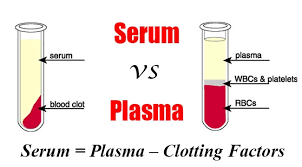Difference between Plasma and SerumContrary to popular misconception, serum and plasma are not the same thing, hence they cannot be used synonymously. You can successfully learn the key distinction between plasma and serum with the help of this article. 
What is Plasma?The liquid component of blood, known as plasma, accounts for around 55% of the total volume of blood and approximately 90% water. Its function is to transport various substances throughout the body, including proteins, minerals, hormones, and antibodies. Since plasma circulates throughout the entire body, cells also discharge their waste into it. Salt, glucose, lipids, water, and protein make up plasma. Plasma usually aids in controlling the body's temperature and blood pressure. Plasma has a lengthy shelf life and can be kept for up to a year. Functions of plasmaYour body's plasma can serve a number of functions. Plasma oversees:
What is Serum?Simply said, it is the fluid portion that lacks cells and the blood clotting component. The blood's protein fibrinogen turns into fibrin when the clotting factor is taken out of the body. Another protein is fibrin, but it cannot be dissolved. By producing a clot and stopping the flow of blood through the wound, it aids in tissue repair. Albumin, fibrinogen, globulin, hormones, nutrients, amino acids, nitrogenous waste, and other substances are found in plasma in addition to water. Notably, the serum has a limited shelf life and can only be stored for a brief time. It is beneficial for identifying issues with cholesterol, blood sugar, blood pressure, etc. When cultivating many diverse types of human cells, human serum produces the best outcomes, but notably when cultivating immune system-related cells. Human serum is added to lymphocyte culture media by researchers to support the development of human lymphocytes and dendritic cells, which are crucial for immunity. In immunohistochemical staining procedures, which determine which foreign antigens elicit an immune response, human serum is used. Human serum is additionally used by researchers in HLA tissue-typing applications to check the compatibility of organ donors and recipients. The best serum for metabolic research is human off-the-clot serum. Laboratories allow entire blood to naturally coagulate without exposure to anticoagulants after collection to get human off-the-clot serum. The serum is then separated from its cellular components in the lab using a centrifuge before the serum is allowed to go through a further clotting process. Any leftover clotting factors are eliminated by allowing the serum to coagulate once more. Laboratories then centrifuge the sample once more before removing the leftover serum and packing it in accordance with the specifications of the researchers. Difference between Plasma and Serum
Separation of Blood Plasma and SerumCentrifugation can be used to separate the makeup of serum and plasma. Notably, each component may be distinguished from the others due to differences in size, weight, and density. To separate blood components like white blood cells and red blood cells from plasma, an anticoagulant called EDTA Heparin is required. However, the procedure for separating serum is difficult. Functions of PlasmaPlasma serves a number of crucial roles because it is an essential component of human blood which are:
Functions of SerumLike plasma, serum serves a variety of purposes, such as:
Understanding the Difference between Plasma and SerumGiven that both plasma and serum are parts of human blood, understanding the differences between them can be a little more challenging. Both plasma and serum serve various bodily purposes. However, both are crucial to the movement of nutrients and other materials throughout the body.
Next TopicDifference between
|
 For Videos Join Our Youtube Channel: Join Now
For Videos Join Our Youtube Channel: Join Now
Feedback
- Send your Feedback to [email protected]
Help Others, Please Share










